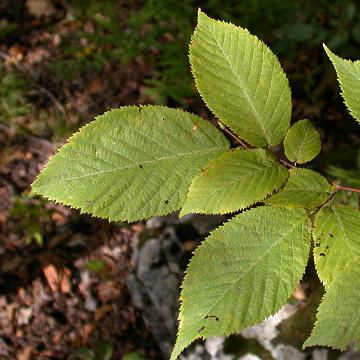

Ostrya virginiana - (image 1 of 6)
Taxonomy
Family: Betulaceae
Habitat
Common in the understory of moist to dry woods.
Associates
Distribution
Throughout much of eastern North America.
Morphology
Medium tree to 20 m. Twigs dark brown with whitish lenticels. Leaves ovate to lance-ovate, short-acuminate, serrate to inconspicuously doubly-serrate, pubescent beneath, teh larger lateral veins often forking before reaching the margin. Staminate catkins dense; scale spirally arranged, depressed ovate and sharp-pointed; pistillate catkins short-cylindric, to 5 cm; bracts ovate, hairy, subtending 2 flowers each; involucre a closed, inflated, flattened ovate sac to 3 cm, bristly as base; nutlet 5 mm. Older bark brownish-gray, exfoliating in long, thin strips.
Notes
Flowers April to May.
Wetland indicator: Facultative Upland -
The fruiting catkins superficially resemble hops, hence the common name. Also called ironwood because of its dense, heavy wood that can quickly dull woodworking tools. Carpinus caroliniana is sometimes also called ironwood for the same reason.
References
Gleason, Henry A. and A. Cronquist. 1991. Manual of Vascular Plants of Northeastern United States and Adjacent Canada. Second Ed.
The New York Botanical Garden. Bronx, NY
Peterson, L. A. 1977. A Field Guide to Edible Wild Plants: Eastern and central North America.
Houghton Mifflin Company. New York, NY
Swink, F. and G. Wilhelm. 1994. Plants of the Chicago Region.
Indiana Academy of Science. The Morton Arboretum. Lisle, Illinois.
|
Michael Hough © 2009 |